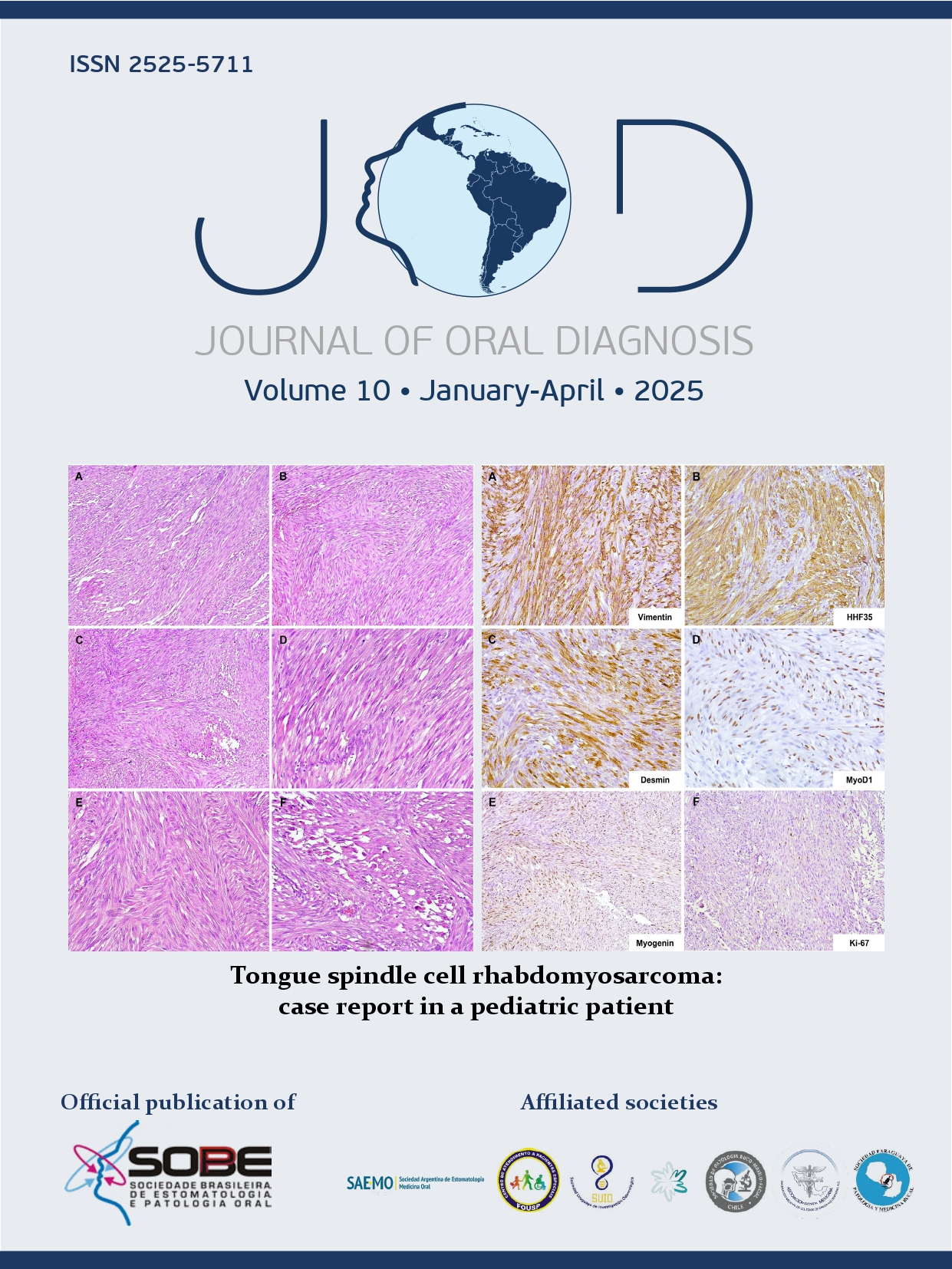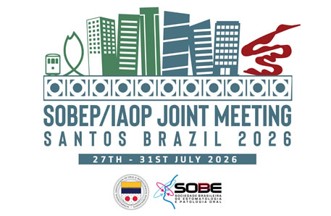Noma (Cancrum Oris): report of a Mexican case
DOI:
https://doi.org/10.5327/2525-5711.310Palavras-chave:
Cancrum oris, Necrotizing gingivitis, NomaResumo
“Cancrum oris” (noma) is a severe necrotizing infectious disease that typically begins as a localized ulcerative lesion of the oral mucosa and rapidly progresses to cause extensive destruction of the orofacial tissues. It predominantly affects individuals with compromised immunity and is strongly associated with malnutrition, poor oral hygiene, and systemic conditions such as HIV infection. We presented the case of a 44-year-old Mexican woman, living with untreated HIV infection, who presented with clinical features consistent with noma in Mexico City. Her management required a coordinated multidisciplinary approach. Although noma is a rare condition in the Americas, it remains a significant public health concern in sub-Saharan Africa. Identified risk factors include extreme poverty, severe malnutrition, inadequate sanitation, and underlying immunosuppressive states such as HIV/AIDS. Histopathological findings demonstrated sharply demarcated necrosis of the surface epithelium, accompanied by peripheral acanthosis and cytoplasmic ballooning of marginal epithelial cells. The underlying dermis showed marked edema with separation of collagen bundles, a dense polymorphonuclear neutrophilic infiltrate, and dilated blood vessels filled with inflammatory cells. Numerous phagocytosed microorganisms were identified, including Gram-negative cocco-bacilli and cocci of variable morphology. Is a polymicrobial infection, the most common pathogen identified is Fusobacterium necrophorum, the synergistic action of multiple anaerobic and facultative organisms, along with their virulence factors, contributes to the fulminant tissue destruction characteristic of the disease. Treatment involves aggressive surgical debridement, antibiotic therapy, and addressing nutritional deficiencies. Noma is a preventable but neglected disease that primarily affects impoverished populations. This case represents both a diagnostic and therapeutic challenge, and to our knowledge, constitutes the first documented instance of adult-onset noma in Mexico. A previous report from 1991 described a pediatric case, but no cases involving adults have been published in the Mexican medical literature to date.
Referências
Whiteson KL, Lazarevic V, Tangomo-Bento M, Girard M, Maughan H, Pittet D, et al. Noma affected children from Niger have distinct oral microbial communities based on high-throughput sequencing of 16S rRNA gene fragments. PLoS Negl Trop Dis. 2014;8(12):e3240. https://doi.org/10.1371/journal.pntd.0003240
Ogbureke KUE, Ogbureke EI. NOMA: a preventable, “scourge” of African children. Open Dent J. 2010;4:201-6. https://doi.org/10.2174/1874210601004010201
Marck KW. Noma: a neglected enigma. Lancet Glob Health. 2013;1(2):e58-9. https://doi.org/10.1016/S2214-109X(13)70035-4
Black RE, Cousens S, Johnson HL, Lawn JE, Rudan I, Bassani DG, et al. Global regional and national causes of child mortality in 2008: a systematic analysis. Lancet. 2010;375(9730):1969-87. https://doi.org/10.1016/S0140-6736(10)60549-1
Enwonwu CO, Falkler Jr WA, Phillips RS. Noma (cancrum oris). Lancet. 2006;368(9530):147-56. https://doi.org/10.1016/S0140-6736(06)69004-1
Enwonwu CO, Falkler Jr WA, Idigbe EO, Afolabi MB, Ibrahim M, Onwujekwe D, et al. Pathogenesis of cancrum oris (noma): confounding interactions of malnutrition with infection. Am J Trop Med Hyg. 1999;60(2):223-32. https://doi.org/10.4269/ajtmh.1999.60.223
Adolph HP, Yugueros P, Woods JE. Noma: a review. Ann Plast Surg. 1996;37(6):657-68. https://doi.org/10.1097/00000637-199612000-00017
Palmer PES, Reeder MM. The imaging of tropical diseases: with epidemiological, pathological and clinical correlation. Oklahoma: Springer; 2000.
Phillips RS, Enwonwu CO, Falkler WA. Pro- versus anti-inflammatory cytokine profile in African children with acute oro-facial noma (cancrum oris, noma). Eur Cytokine Netw. 2005;16(1):70-7. PMID: 15809209.
Enwonwu CO, Falkler WA, Idigbe EO. Oro-facial gangrene (noma/cancrum oris): pathogenetic mechanisms. Crit Rev Oral Biol Med. 2000;11(2):159-71. https://doi.org/10.1177/10454411000110020201
Zushi Y, Noguchi K, Moridera K, Takaoka K, Kishimoto H. Osteonecrosis of the jaw in an AIDS patient: a case report. AIDS Res Ther. 2015;12;13. https://doi.org/10.1186/s12981-015-0049-8
Feller L, Khammissa RAG, Altini M, Lemmer J. Noma (cancrum oris): an unresolved global challenge. Periodontol. 2000;80(1):189-99. https://doi.org/10.1111/prd.12275
Feller L, Lemmer J. Necrotizing periodontal diseases in HIV-seropositive subjects: pathogenic mechanisms. J Int Acad Periodontol. 2008;10(1):10-5. PMID: 18333595.
Khammissa RA, Ciya R, Munzhelele TI, Altini M, Rikhotso E, Lemmer J, et al. Oral medicine case book 65: necrotizing stomatitis. SADJ. 2014;69(10):468-70. PMID: 26506800.
Limongelli WA, Clark MS, Williams AC. Noma-like lesion in a patient with chronic lymphocytic leukemia. Review of the literature and report of a case. Oral Surg Oral Med Oral Pathol. 1976;41(1):40-51. https://doi.org/10.1016/0030-4220(76)90250-4
Masipa JN, Baloyi AM, Khammissa RAG, Altini M, Lemmer J, Feller L. Noma (cancrum oris): a report of a case in a young AIDS patient with a review of the pathogenesis. Head Neck Pathol. 2013;7(2):188-92. https://doi.org/10.1007/s12105-012-0393-0
Feller L, Altini M, Chandran R, Khammissa RAG, Masipa JN, Mohamed A, et al. Noma (cancrum oris) in the South African context. J Oral Pathol Med. 2014;43(1):1-6. https://doi.org/10.1111/jop.12079
Mead SV. Oral surgery. St. Louis: Mosby; 1946.
Van Damme PA, Sokoto noma-team 19, September 2002. Noma. Lancet Infect Dis. 2004;4(2):73. https://doi.org/10.1016/S1473-3099(04)00924-7
Downloads
Publicado
Como Citar
Edição
Seção
Licença
Copyright (c) 2025 Fernanda Figueroa, Adalberto Mosqueda Raylor, Marysol Macedo Perez, Cristina Berumen Glinz, Maria Elisa Vega Memije, Sonia Toussaint Care

Este trabalho está licenciado sob uma licença Creative Commons Attribution 4.0 International License.













